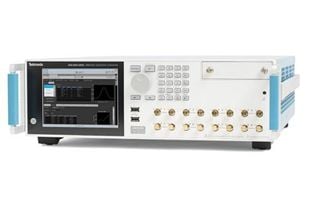연락처
텍트로닉스 담당자와 실시간 상담 6:00am-4:30pm PST에 이용 가능
전화 문의
9:00am-6:00PM KST에 이용 가능
다운로드
매뉴얼, 데이터 시트, 소프트웨어 등을 다운로드할 수 있습니다.
피드백
탁월한 신호 충실도를 통한 고품질 신호 수집
회전 분광법을 사용하면 가스 혼합물의 구성 분자를 정확히 식별할 수 있을 뿐만 아니라 테스트 챔버 내의 순간별 화학반응을 연구할 수 있습니다. 이러한 응용 시의 난점 중 하나는 스펙트럼 선의 진폭의 광범위성으로 인해 수집 시스템에 매우 높은 동적 범위가 요구된다는 점입니다. 연구자들은 평균화를 사용하여 오실로스코프의 동적 범위를 확장하며, 오실로스코프는 최대한 빠른 시간 내에 수십에서 수백만 건의 수집을 수행하는 성능을 발휘해야 합니다.
마이크로파 분광법의 적용 범위를 확장하기 위해 새로운 기술이 계속 만들어지고 있습니다. 오늘날 연구자들은 순간별로 화학반응을 분석하는 데 집중하고 있습니다. Tekronix는 변화하는 요구 사항을 지원하기 위해 실시간 스코프에서 이 작업의 새로운 기능을 추적하고 있습니다.
마이크로파 및 밀리미터파 신호의 직접 수집
회전 분광법은 기체 시료를 통해 마이크로파 또는 밀리미터파 처프(chirp)를 전송하고, 광대역 신호 수집 시스템으로 수신 신호를 수집하고, 시간 영역의 데이터를 주파수 영역의 데이터로 변환한 다음 마지막으로 수집한 데이터를 특정한 분자의 이론적 스펙트럼 구성과 패턴 매칭하여 기체 시료의 실제 내용물을 식별합니다. Tek에서는 최대 70GHz까지 직접 수집할 수 있는 실시간 스코프를 제공합니다. 이러한 장비를 사용하면 상향/하향 변환기를 제거하여 신호 경로에서 잠재적인 오류 요소와 노이즈 원을 줄일 수 있습니다.
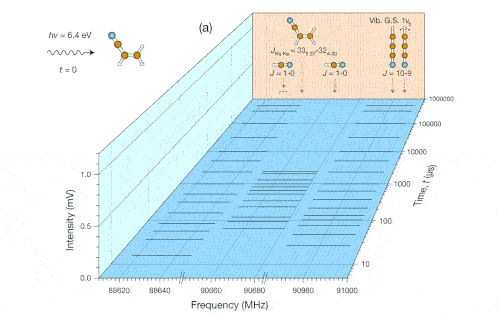
분광기의 미세 시간 분해능에서 획득한 CH2CHCN을 t=0에서 광분해하여 나온 HCN, HNC 및 HCCCN의 CP-FTmmW 신호의 시간적 변화입니다. Journal of Physical Chemistry Letters에 게재된 "Time-Resolved Kinetic Chirped- Pulse Rotational Spectroscopy in a Room-Temperature Flow Reactor(상온 흐름 반응기에서의 시간 분해능을 갖는 속도론적 처프 펄스 회전 분광법)"에서 승인을 받아 재인쇄(개작)되었습니다. 저작권 2018 미국 화학 협회(American Chemical Society)
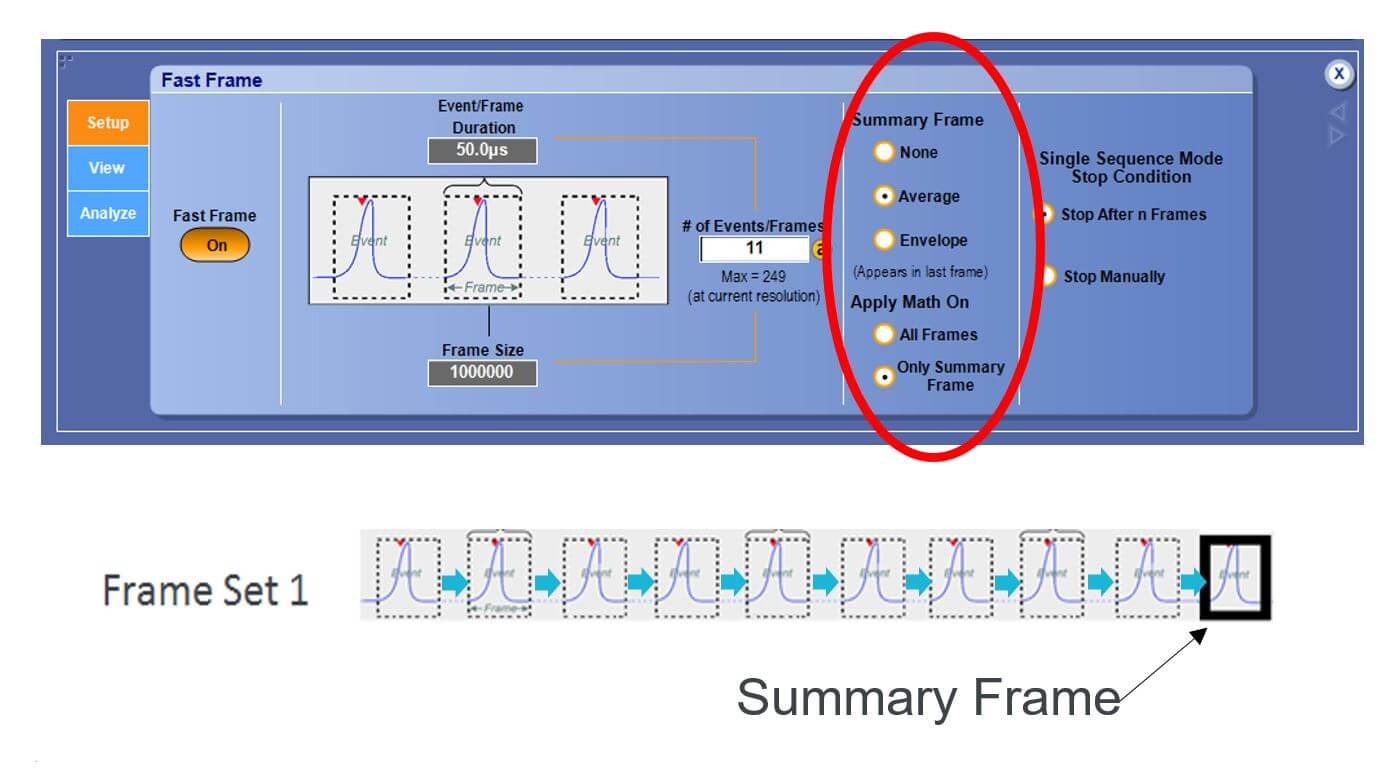
수집 시스템의 하드웨어 평균화를 사용하면 아주 빠른 계산이 가능하며, "요약 프레임 전용" 모드를 사용하면 수집 시스템 내의 데이터가 크게 줄어 오실로스코프 내에서 파형 데이터를 수집 보드에서 PC 마더보드로 전송하는 데 소요되는 시간이 감소합니다. 이 두 가지 기능을 함께 사용하면 분석 처리량이 크게 향상됩니다.
하드웨어 평균화와 요약 프레임 기능을 사용한 정적 시료의 수집 시간 단축
회전 분광법으로 수집한 신호의 동적 범위를 확장하려면 다량의 신호 평균화를 수행해야 합니다. 일반적으로 이러한 평균화는 수집 시간의 장기화로 이어지지만 Tektronix의 모든 고성능/초고성능 실시간 스코프에서 사용할 수 있는 독점 기술은 수집 보드에 내장된 하드웨어 평균화를 사용하여 데이터 수집 속도를 높입니다.
Tek 스코프의 표준 기능으로 사용할 수 있는 "요약 프레임 전용" 모드를 통해, 수집 하드웨어는 모든 프레임에서 점별 평균화를 수행하고 요약 프레임에 확장된 동적 범위와 향상된 신호-노이즈 비율을 제공합니다. 요약 프레임 데이터만 필요한 경우 스코프의 수집 보드에서 스코프의 내부 PC 시스템으로 전송해야 할 데이터의 양이 절감되어 상당한 시간이 절약됩니다. 예를 들어 1,000 프레임을 전송하는 대신 요약 프레임만 전송하면 되므로 1000:1의 데이터 절감이 이루어집니다.
순간별 화학반응 분석에 이용할 수 있는 평균화 시간 단축 및 데이터 감소
연구자들이 화학반응을 분석하는 순간별 실험이 개발되면서 정적 시료 분석에 비해 요구되는 데이터 수집량이 훨씬 늘어났습니다. Tektronix는 이러한 새로운 요구 사항을 충족하기 위해 "직교 FastFrame 평균화" 모드를 개발했습니다. 해당 스코프는 여러 프레임 집합의 수집에서 가져온 평균 프레임 집합을 생성하여 획기적으로 수집 시간을 단축합니다. 평균화가 완료되면 남는 것은 평균 프레임 집합입니다. 다시 설명하지만, 1,000 집합을 수집하여 평균화하면 그 결과로 산출된 평균 프레임 집합은 해당 스코프의 PC 보드로 전송 시 1000:1의 데이터 감소를 보여줍니다.
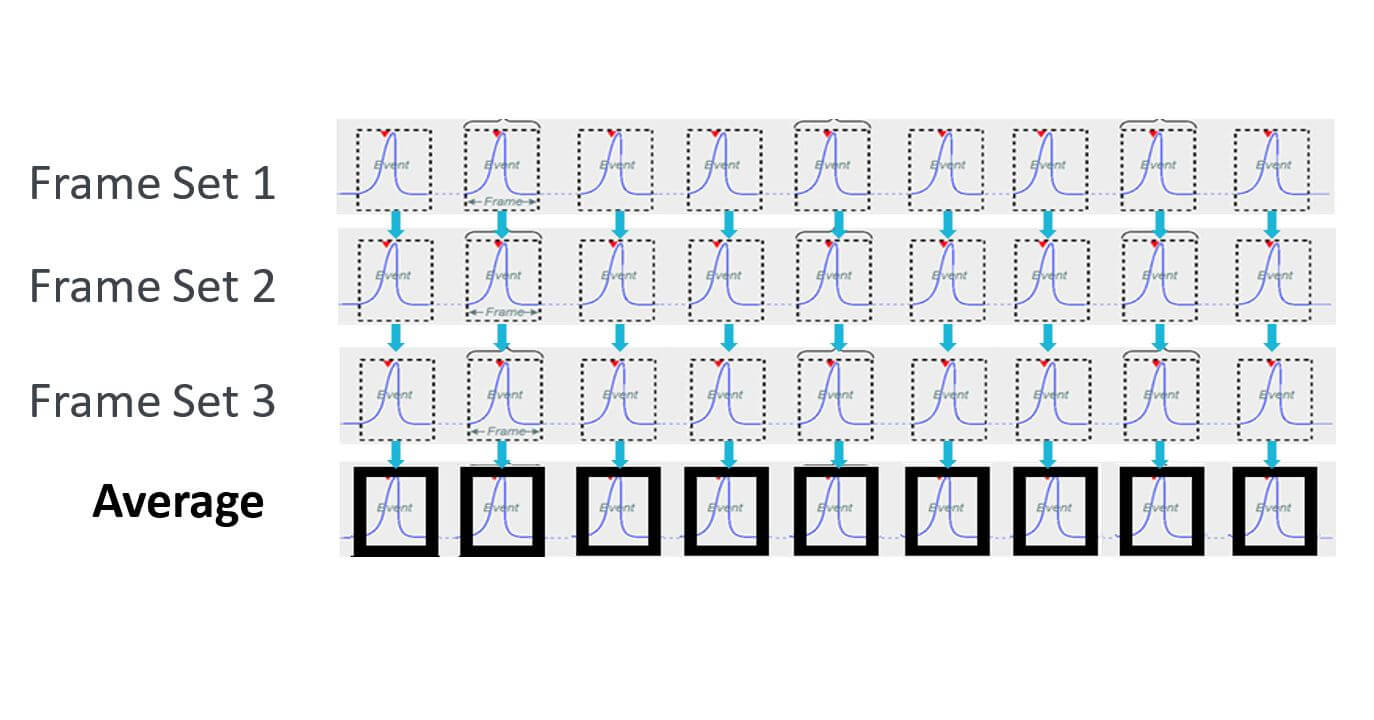
직교 FastFrame 평균화를 사용하면 여러 집합의 프레임을 단일 평균 프레임으로 평균화하는 효과적인 하드웨어 평균화를 수행할 수 있습니다. 예를 들어, 각 첫 번째 프레임을 점별로 수집한 다른 모든 "첫 번째 프레임"과 함께 평균화하면 "첫 번째 평균 프레임"이 생성됩니다. 이 프로세스는 다른 모든 프레임에 대해 반복되어 각 프레임 사이에 6uS의 짧은 간격 시간으로 각 순차 상태를 나타내는 고해상도 데이터를 생성합니다.
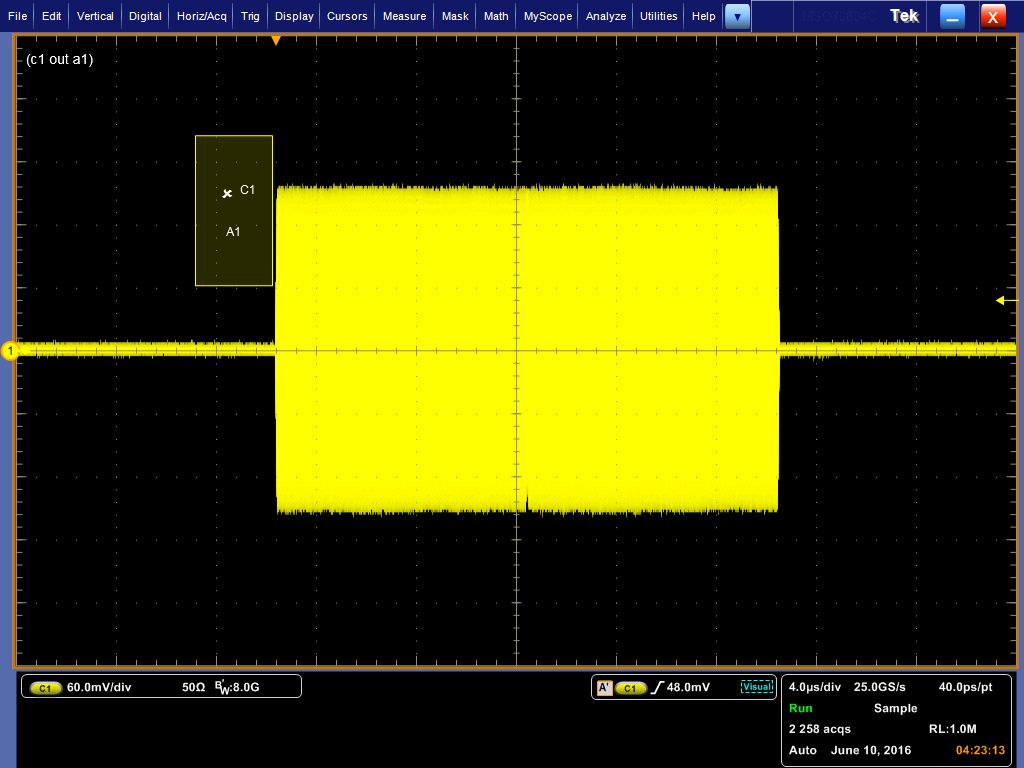
사전 보정 프로세스는 AWG 및 연결된 동축 케이블의 진폭 및 위상 응답을 측정했고, 이 응답을 보정하는 필터를 만든 다음, 파형을 미리 왜곡하여 그 결과로 나온 출력값을 평탄하게 만들었습니다.
신호 경로 손실 및 반사에 대한 데이터 보정
스펙트럼적으로 가장 순수하고 진폭이 정확한 데이터 집합을 수집하려면 보정 필터로 수집한 데이터를 보정해야 합니다. Tek에서는 이 보정 작업을 다루는 두 가지 솔루션을 제공합니다.
Tek AWG 및 Tek 실시간 오실로스코프를 사용하는 경우에는 자동 프로그램을 사용하여 사전 왜곡 필터를 만들 수 있습니다. 그런 다음 이 필터를 본래의 AWG 파형 데이터에 적용하면 "미리 왜곡된" 또는 "사전 보정된" 파형이 생성됩니다. 이 보정 작업은 시스템 요소(케이블, 상향/하향 변환기, 안테나 등)로 인해 AWG 출력값과 스코프의 입력값 사이에서 발생하는 진폭 및 위상 편차를 자동으로 교정합니다. 이 기술은 AWG에서 생성되는 신호를 수정하므로 수집 효율성에는 영향을 미치지 않습니다.
시리얼 데이터 링크 분석(SDLA)이라는 더욱 강력한 보정 도구도 있습니다. 이 도구는 진폭과 위상 편차뿐만 아니라 반사도 교정하는 필터를 만들어 냅니다. SDLA에 S-매개 변수 데이터(일반적으로 VNA를 사용해 생성됨)를 입력하면 FIR 필터가 출력되며, 이 FIR 필터는 스코프의 Math 채널을 사용하여 수집할 때마다 스코프 데이터에 자동으로 적용됩니다. 이 필터를 최종 데이터 집합에 적용하면 수집 효율성에 미치는 영향을 최소화할 수 있습니다.





